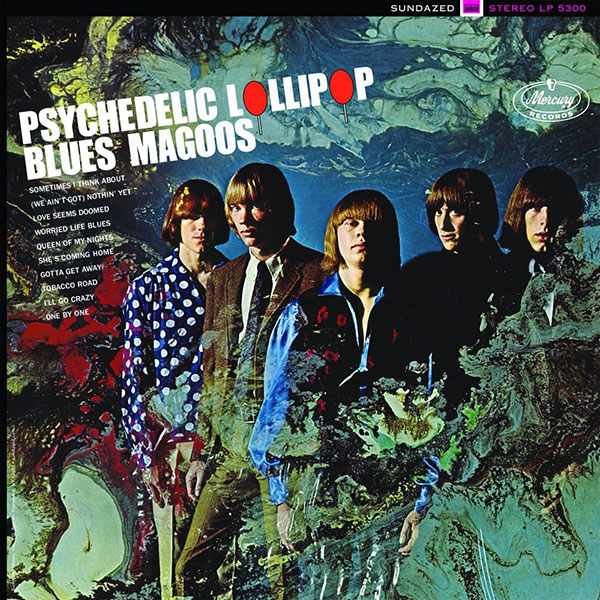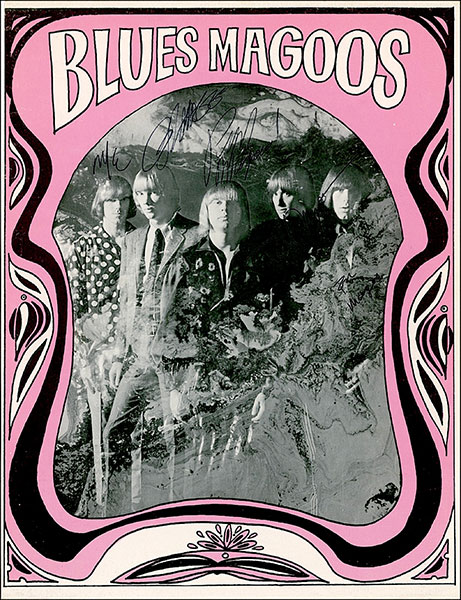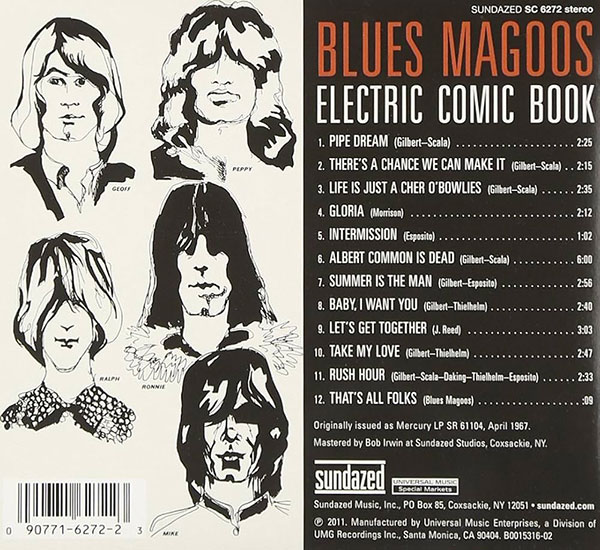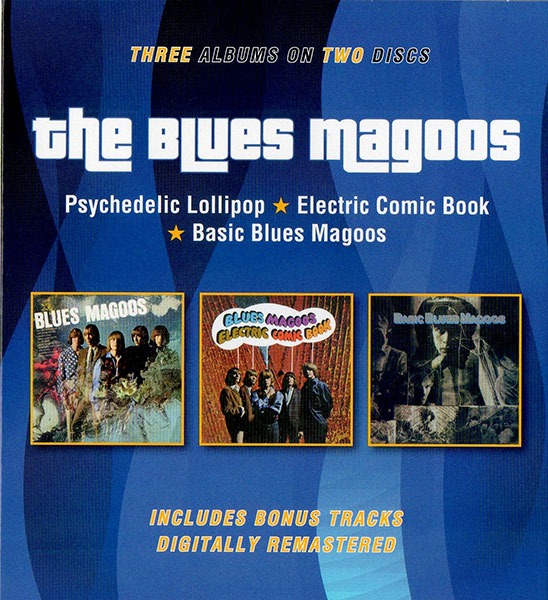
Overview of:
THE BLUES MAGOOS
‘Psychedelic Lollipop’/ ‘Electric Comic Book’/ ‘Basic Blues Magoos’
(April 2025, BGO Records 5-017261-215383)
Although they were street kids from the Bronx – an address more usually associated with the Italianate Doo-Wop of Dion & The Belmonts, the Blues Magoos were early adapters. Lenny Kaye selected their ‘Tobacco Road’ for the first Nuggets: Original Artyfacts From The First Psychedelic Era 1965-1968 compilation. And it was their ‘(We Ain’t Got) Nothin’ Yet’ with its piping Farfisa organ, which was the closest they came to a hit single – peaking at no.5 on Billboard in July 1967. High on the first wave as American Rock groups began to get more freaky-weird, the Magoos were moments ahead of the curve. They’d played the Greenwich Village ‘Night Owl Café’ – a venue instrumentally hymned by the Lovin’ Spoonful, they had their hair styled by Christopher Pluck at Vidal Sassoon, they wore haute couture clothes designed by Diana Dew who pioneered electronic textiles, they used giant onstage lava-lamp lighting, and they named their debut album Psychedelic Lollipop at a time when the word was still a novelty. Simply on that title alone they ‘must have sold tens of thousands in acid-happy San Francisco’ according to Lillian Roxon of the New York Sunday News.

The story began in the most un-hoodlum environs of the Dewitt Clinton High School golf team, when organ-playing singer Ralph Scala (‘quiet, shy, goodlooking’ according to the LP liner-notes) met Ron Gilbert (‘loud, funny, lazy,’ bass guitarist) and formed the Trenchcoats. It was 1964, the other original members were 13-year-old Emil ‘Peppy Castro’ Thielhelm (‘an idol, loveable, ‘17’, drop-out,’ vocals and rhythm guitar), Dennis LePore (lead guitar), and Jon Finnegan (drums). By 1965 they’d become the Bloos Magoos, and begun to garner a reputation around hip Greenwich Village clubs, and the Café Wha on McDougal Street. ‘We started as part of the transition in the Village as it went from Folk to electric’ recalls Castro, ‘every single act was different, no one was on the bandwagon.’
Mr Magoo was a short-sighted cartoon character voiced by Jim Backus, created by the UPA studio in 1949, but was regularly recycled on 1960s TV. Magoos rhymes with the Blues…? Maybe that was enough? After all, they did close their second album with a brief nine-second ‘That’s All Folks’ Loony Tunes spoof! So, by the early months of 1966, they’d settled on being the Blues Magoos in time for Mike Esposito (‘psyched-out, warm, friendly’) to replace Dennis LePore – bringing his controlled feedback and tape-echo effects, and Geoff Daking (‘blond, beautiful, straight’) to wrest the drum-chair from Jon Finnegan.
Although a one-off single for Verve – ‘So I’m Wrong And You Are Right’ c/w ‘The People Had No Faces’ (February 1966, Verve Folkways KF5006), written and produced by Rick Shorter, vanished without trace, they were picked up by Mercury through the good grace intervention of Longhair Productions, who were Bob Wyld & Art Polhemus. The single ‘Tobacco Road’ c/w ‘Sometimes I Think about You’ (Mercury 72590) followed in June 1966 as a trailer for Psychedelic Lollipop. The song had already been a hit for the British Nashville Teens, was also recorded on the pre-Grace Slick Jefferson Airplane Takes Off (1966), and by Los Angeles group Leaves on their debut album Hey Joe (1966). But, extended to 4:41-minutes with discordant accelerating chock-a-chock rhythms and scratched fretboard effects, it made waves sufficient to attract enough attention to shove the Esposito-Scala-Gilbert ‘(We Ain’t Got) Nothin’ Yet’ c/w ‘Gotta Get Away’ (Mercury 72622) high into the chart. Archivist Mike Stax says that the hit was ‘based around a nifty bass riff and an infectiously exciting vocal delivery, the song takes off like a rocketship when Mike Esposito escalates into a brilliant Echoplexed guitar solo.’ There was a buzz in the air. It was one of the first of the happening wave of Punk-Garage Rock that was shaking up the established Pop order. In the UK, Melody Maker devoted a two-page centrespread to announcing the new phenomenon that was Psychedelic Music.
Sales were blunted in the UK as ‘(We Ain’t Got) Nothin’ Yet’ was covered by a group called the Spectres on Pye Piccadilly 7N35368, just months before they name-switched to Status Quo. Yet ‘pirate’ deejay John Peel played the Magoos on his ‘Perfumed Garden’ broadcasts. And there’s just a coincidental hint in the Magoos’ sway carried over into Deep Purple’s ‘Black Night’ some few years into the future.
In another first, Psychedelic Lollipop carried a ‘Play At High Volume’ tag. For the notes supplied by the Nuggets CD-box package, ‘with its heavy use of effects and improvisational segments, the album showed a band toying with the possibilities of psychedelia without ever taking themselves too seriously – a sense of humour was never far below the surface.’ While their ‘Tobacco Road’ ‘was a highlight of the Magoos live act and demonstrates how effectively the earlier garage-psych bands were able to utilise experimental sounds and controlled dynamic without ever overextending into self-indulgent jamming.’ There was the Mod R&B of James Brown’s ‘I’ll Go Crazy’ (2:02), the lushly-romantic ‘Queen Of My Nights’ (3:03) and the dual voices and tempo-shifting ‘Love Seems Doomed’ (3:01) which breaks into a whooping Floydian electro-vortex.
Side two has the ascending harmonies and bratty ‘I want to be FREE!’ vocals of ‘Gotta Get Away’ (2:42), and the ‘House Of The Rising Sun’ tip of the New Orleans hat of ‘Sometimes I Think About’ (4:11), just as their arrangement of the slow moody ‘Worried Life Blues’ (3:52) takes its template from the earlier Animals version. Then the anthemic ‘One By One’ (2:51) that wisely insists ‘time goes by so very fast, and you know your younger years won’t last, so take these childhood dream as they come, and learn to live each day.’ Until lascivious temptations crawl all over the final cut – ‘She’s Coming Home’ (2:43), as he resists the lure of the girl who drives him insane, turns him on and gets to his brain, because the real woman of his life is due to return. It’s an album that burns with the snotty attitude of sniffing airplane-glue, hormonal energy and naivety. By now, according to producer Bob Wyld’s sleeve-notes, the Blues Magoos were taking over the ‘minds and imaginations of the critics, poets, writers, artists, ‘groupies’, record executives, disc jockeys and even Madison Avenue,’ as they glower out of the paint-pattered swirl of the cover-photo in their identical pudding-bowl Brian Jones fringes, and a single Op-art spotted shirt.

Electric Comic Book spun off a follow-up single, ‘There’s A Chance We Can Make It’ (2:14) c/w ‘Pipe Dream’ (2:25) (February 1967, Mercury 72660) which made less of a splash, both sides are less obvious than ‘(We Ain’t Got) Nothin’ Yet’, and it peaks no higher than no.60. Deemed a drug-song, ‘Pipe Dream’ was denied radio airtime, although Castro says ‘no, it was an anti-drug song!’ and the lyric stresses ‘come back to reality.’ They play it on the TV ‘Smothers Brothers Comedy Hour’, with a jokey introduction sequence, a clip of their ‘far-out brand of psychedelic music’ that has been preserved on YouTube. Both tracks were thrusting excursions, but more textured with harmonies than before, only sprinkled with guitar and organ effects. The album’s first side standout is Them’s ‘Gloria’ (6:02) with a distorted mid-point guitar solo – the song was a litmus on which every American garage-band cut its teeth. The album sleeve featured its own Comic-Book offering ‘the Psyche-de-lite to turn you on while you play the album’ to create ‘a Blues Magoos Concert in your own home,’ for ‘transistorised come-as-you-are minds.’ Side one closes with the 1:06 ‘Intermission’ in which they take a break to have a ‘little smoke, and powder our nose’ before you turn the record over and ‘dig the other side.’ The nature of the smoke, and the powder involved is purposefully left open to interpretation.
There’s a higher ratio of softer material this time around, ‘Summer Is The Man’ (3:00) has quasi-mystical ‘he sees the beauty in a flower’ aspirations, ‘Baby, I Want You’ (2:43) is a teen-romance in which she’s left him to discover the wider world, while ‘Take My Love’ (1:51) is a dancey organ-led piece saved by the slight suggestiveness of ‘take my love and shove it up your… heart.’ ‘Shove it, Momma’ he adds by way of emphasis. ‘Life Is Just A Cher O’Bowlies’ (2:35) takes its jokey title to ask ‘what’s the use of singing this song? Some of you aren’t even listening!’ with tasty guitar licks and harmonies rising into a vaudevillian ‘Thank you!’. ‘Albert Common Is Dead’ (1:50) is about escaping the boring ‘straight’ world, ‘your job is big, your pay is small, your income tax takes it all.’ Then ‘Let’s Get Together’ (3:07) reverts to punky Blues, with background party noises drowned by grungy guitar. Until ‘Rush Hour’ (2:35) is dense with snarling menace, slashed by bullet-zing sounds, the track builds from ‘all aboard’ to the manic intensity of ‘last stop’ through ‘flashing lights and freaky signs’ that leave the listener wondering what kind of rush we’re on.
Meanwhile the group were touring with Herman’s Hermits and the Who through until September. Maybe it was exposure to the Who’s harder edge, plus a retreat to rehearsals in their own Bronx redoubt that invests their next long-player with a more progressive Mod freakbeat orientation, most perfectly encapsulated by their cover of ‘I Can Hear The Grass Grow’ (2:18). Roy Wood had the unique ability to write catchy Pop hits that were sufficiently lyrically vague to escape BBC censors but deep enough for counterculture heads to nod along to hidden meanings. And The Move never had American hits, so the songs were fair game. Recorded free of management and label interference, the Magoos used a remote truck-mobile studio, yet Basic Blues Magoos was described as ‘rampant and discordant’ by Phil Hardy & Dave Laing (in ‘The Encyclopedia Of Rock Vol.2’, Granada Books, 19767) but also ‘largely forgettable’.
‘Sybil Green (Of The In-Between)’ (2:42) enchants with a more beguiling Anglocentric whimsy, a bucolic flavour to its harmonies, with phasing across the stereo channels as Sybil finds herself in the space between her books. ‘Yellow Rose’ (2:30) is a stripped-back acoustic ballad, while ‘All The Better To See You With’ treats its fairy-tale title to a blend of harmony interplay over a hard repetitive riff. ‘I Wanna Be There’ (2:58) is the lament of a touring Pop group who are ‘living out of a suitcase,’ while ‘There She Goes’ (2:50) is electro-beat-group with flowers in her hair. ‘You’re Getting Old’ (4:15) has macabre touches, ‘you’re getting closer to your grave’ which contrasts with its lively guitar break.

To the freakier end, ‘Scarecrow’s Love Affair’ (4:01) has phased vocals throughout, dissolving into electronic storm and engine sounds, while ‘Accidental Meditation’ (1:42) is a reflective instrumental, as ‘Subliminal Sonic Laxative’ (1:05) consists of nothing more than a low electronic burr. ‘President’s Council On Psychedelic Fitness’ (2:44) ducks and swerves with screaming vocals, rich keyboards and stabbing guitar – ‘we’re not here to blow your mind, we’re here just to help our kind’, while ‘Chicken Wire Lady’ (4:07) opens with growling guitar overlayed with darting solo playing, ‘reflecting the British underground sound. It’s not that the Pop edge has gone, it’s simply been expanded’ according to Nick Dalton’s notes in the 2025 BGO Records CD-package. Yet it was a good, varied album. Even if there’s also a sense that, by sophisticating their sound – as with the ambitiously progressive ‘I Can Move A Mountain’ (3:50), they’re moving away from the rawness that formed their attraction in the first place.
After which, things went seriously awry – ‘one, two, three, four, we’re here today, and gone tomorrow, and who knows who we are?’ (‘President’s Council’); management, producers and record labels exacerbated the situation as with many bands at the time, and they split into two factions. Emil ‘Peppy Castro’ Thielhelm recruited Eric Kaz (keyboards), Richie Dickon (drums), John Leillo (vibes) and Roger Eaton (bass) and signed to ABC Records for Never Goin’ Back To Georgia, and then, when Roger Eaton quit, they drew on session-players for the ‘electronic storm’ – Hardy & Laing’s description, that was Gulf Coast Bound. Meanwhile, Scala, Gilbert and Daking had relocated to the West Coast where they added Ted Munda (replacing him with Joey Stec) and issued a rare single ‘Let Your Love Ride’ c/w ‘Who Do You Love’ for the small Ganim label before litigation forced them to drop claims to the Blues Magoos name… although both sides of the single were later added as bonus tracks to the 2004 Repertoire expanded CD edition of Basic Blues Magoos.
The scattered history continued as the LA faction renamed themselves the Dependables, and recorded a 1971 album named after a phrase taken from The Day The Earth Stood Still 1951 movie, Klatu Berrada Niktu (United Artists UAS-6799, reissued in the UK in 2003 as Rev-Ola CR REC50). The album includes Sam & Dave’s ‘I Take What I Want’ and Ike Turner’s ‘Get It, Get It’, as well as new compositions largely by Ralph Scala-Joey Stec. While, after the final Blues Magoos split Emil ‘Peppy Castro’ Thielhelm performed as part of the Broadway cast of Hair, recorded two albums as Barnaby Bye with identical twins Bobby & Billy Alessi – who had their own hit as the Alessi Brothers in 1977 with ‘Oh Lori’, and Peppy even scored that elusive next hit with the soft-rock band Balance, who achieved a 1981 no.22 Billboard chart placing with the bass-heavy ‘Breaking Away’. Eric Kaz formed a supergroup called American Flyer, with Doug Yule (ex-Velvet Underground), Craig Fuller (of Pure Prairie League) and Steve Katz (formerly of Blood Sweat & Tears). Their first of two albums was produced by George Martin, from which ‘Let Me Down Easy’ provided them with a no.80 hit single.
Inevitably, with disagreements and grudges put on hold, there was an eventual Blues Magoos reunion in 2008, with Scala, Castro and Daking playing concerts together, one at the New York Fillmore on a bill with the Zombies. There were also a couple of reunion recordings, in Psychedelic Resurrection (2014) and a single ‘Nowhere Is Somewhere’ (2022). Ron Gilbert died 16 February 2024, aged 77.
Meanwhile, this value-for-money compilation includes everything from the quintet’s first two albums of hard freakbeat garage-Rock, blending into the full Bluesier third set including their opportunistic cover of Roy Wood’s ‘I Can Hear The Grass Grow, plus both sides of their novelty single ‘Jingle Bells’ c/w ‘Santa Claus Is Coming To Town’ (1967, Mercury 72762). As we have seen, there was more for the Magoos, but this is all you really need.
BY ANDREW DARLINGTON
The Albums:
October 1966 ‘Psychedelic Lollipop’ (US, Mercury SR61096, UK Fontana STL5402) includes a four-&-a-half minute version of John D Loudermilk’s ‘Tobacco Road’, giving way to a guitar-thrash workout, Folkie David Blue’s ‘Queen Of My Nights’, James Brown’s ‘I’ll Go Crazy’ and hit single ‘(We Ain’t Got) Nothin’ Yet’. The album hit no.21 on the US album chart.
April 1967 ‘Electric Comic Book’ (US, Mercury MG21104) includes Van Morrison’s ‘Gloria’ and 0.09 ‘That’s All Folks’ spoof Loony Tunes theme. The title of ‘Albert Common Is Dead’ spells A-C-I-D. It peaked at no.74 on the Billboard LP chart, although it hit no.14 in Canada (RPM album chart).
May 1968 ‘Basic Blues Magoos’ (US, Mercury SR-61167) includes Roy Wood’s ‘I Can Hear The Grass Grow’, ‘President’s Council On Psychedelic Fitness’ (R Scala & R Gilbert) and the 1:00 ‘Subliminal Sonic Laxative’ credited to the group. The album failed to chart.
1969 ‘Never Goin’ Back To Georgia’ (US, ABC Records ABCS-697), a new line-up, includes the Elvis hit ‘Heartbreak Hotel’ and Willie Dixon’s ‘Heart Attack’.
1970 ‘Gulf Coast Bound’ (US, ABC Records ABCS-710) includes 12:21 The NME review calls them ‘a jazz-orientated group’ and says that ‘Can’t Get Enough Of You’ ‘develops into a musical treat, giving various instrumentalists a chance to shine’ – the twelve-minute track was edited down to 3-&-a-half minutes for a single, while ‘the sax playing of Pee Wee Ellis comes over best of ‘Slow Down Sundown’. For Melody Maker ‘Blues Magoos, an American band, drone on with menace with the aid of conga drums and a saxophone.’ Also ‘Magoo’s Blues’.
2007 ‘Kaleidescopic Compendium: The Best Of The Blues Magoos’ (US, Mercury 314-512-313-2) CD compilation
October 2014 ‘Psychedelic Resurrection’ (Kayos) includes guest cameos by Ronnie Gilbert and Mike Esposito
April 2025 ‘Psychedelic Lollipop’/ ‘Electric Comic Book’/ ‘Basic Blues Magoos’ (BGO Records 5-017261-215383) includes the full first three albums in a single slip-case edition, with bonus tracks ‘Dante’s Inferno’, the B-side of the single ‘One By One’ (May 1967), and ‘Jingle Bells’ and its B-side ‘Santa Claus Is Coming To Town’ (December 1967).
.
